Wednesday 1 April, 2015, 11:01 - Spectrum Management
Posted by Administrator
It is almost a law of physics, that the best way to increase the coverage of a transmitter is not simply to turn up the power, but better still to increase the height of the transmitting antenna. Wireless Waffle has discussed the relationship between height, power and coverage before. It is, however, almost a law of nature, that increasing the height of an antenna through building a taller mast will incur the wrath of residents and environmental protestors and as such, there is a political limit to just how high antennas can be mounted.Posted by Administrator
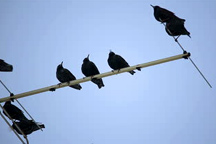 Wouldn't it be great if someone invented invisible, or nearly invisible antennas? One option might be to use atom thin superconducting graphene tubes that were self-supporting but so thin as to be virtually invisible. The only downside of such an antenna would be that any bird that flew into it would be immediately sliced in two as the antenna would have almost infinitely sharp edges.
Wouldn't it be great if someone invented invisible, or nearly invisible antennas? One option might be to use atom thin superconducting graphene tubes that were self-supporting but so thin as to be virtually invisible. The only downside of such an antenna would be that any bird that flew into it would be immediately sliced in two as the antenna would have almost infinitely sharp edges.Another option could be to use multiple beams to project and focus energy at a specific point to materialise a virtual antenna. If force (thrust) can be generated by electromagnetic waves in an EmDrive, then could a similar principal be used to project an antenna at a point away from the source of the physical beams? This far-fetched idea is being considered by Professor Nisan Sakasi at the Communications and Spectrum Management Research Centre at the University of Bilkent, in Turkey.
By focussing very narrow microwave beams which cross in a specific quadrifilar pattern, the air atoms at that point can be ionised to become electrically conductive and with careful tuning,
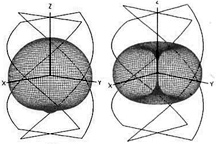 can project a virtual antenna at a point separated from the microwave transmitters by several metres. Professor Sakasi has called the antennas 'polar foil', because the area where the virtual antenna is formed, if viewed from polar angles, glints a little like aluminium foil. Of course at night they are completely invisible.
can project a virtual antenna at a point separated from the microwave transmitters by several metres. Professor Sakasi has called the antennas 'polar foil', because the area where the virtual antenna is formed, if viewed from polar angles, glints a little like aluminium foil. Of course at night they are completely invisible.The difficulty for the team at Bilkent is now to find a way of feeding the polar foil with RF energy so that it can actually radiate useful signals. The team believe that with the right beamforming, a 'virtual feeder' could also be created permitting injection of RF signals from a lower point. A secondary problem is that the amount of electricity needed to feed the microwave transmitters which generate the polar foil is 'in the region of kiloWatts', meaning that the power required to form the virtual antennas is currently far more than that required to generate the radio signals that would feed into them.
The advantages of such a system is that, with tighter beamforming, it may be possible to generate the polar foil not just metres away from the microwave transmitters but tens of metres away. As such, antennas could be virtualised far above the ground, without the need to build masts at all. The fact that the antennas are virtual, and not real, means that problems like slicing a bird in half as it flies into the antenna are virtually unreal and thus no damage would be caused.
A spokesperson for the Royal Society for the Protection of Birds, told Wireless Waffle that:
We are very concerned about the idea of superconducting graphene antennas being erected across the country, however we think that many birds would like the idea of a network of virtual feeders!
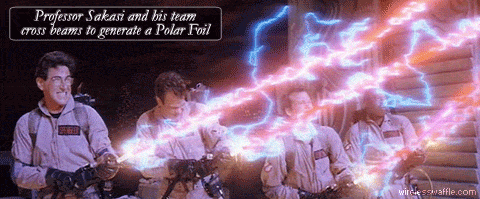
add comment
( 238 views )
| permalink
| 



 ( 2.9 / 3950 )
( 2.9 / 3950 )




 ( 2.9 / 3950 )
( 2.9 / 3950 )
Friday 27 February, 2015, 15:09 - Spectrum Management, Much Ado About Nothing
Posted by Administrator
Experts at the University of Surrey have allegedly achieved wireless data transfer speeds of 1Tbps (Terabits per second), albeit in laboratory conditions and over a distance of just 100 metres. Sizzle! Then again, just imagine the cost of rolling out the 10 million or so cell sites that would be needed to cover the UK. Ow! Nonetheless this is a significant achievement. Yay!Posted by Administrator

Mobile data connections working this fast would be able to transfer the contents of a blu-ray disk (typically 50 GigaBytes) in just under half a second. Wow! At typical current average mobile internet tariffs, the cost of transferring the data for the blu-ray would be around GBP200. Wowzer! Assuming you wanted to do this every day, the monthly cost of your mobile contract would be around GBP6000. Zowee!
Do we really need to say any more?
Thursday 22 January, 2015, 10:48 - Amateur Radio, Broadcasting, Licensed, Radio Randomness, Spectrum Management
Posted by Administrator
Radio amateurs with designs on operating from the planet Mars are appealing against a decision by the Consultative Committee for Space Data Systems (CCSDS) to allocate the 70 cm amateur band (430 - 440 MHz +/-) for communications between satellites in orbit around the red planet and the numerous rovers that criss-cross its surface. Posted by Administrator
In a statement, released by the Mars United People for Planetary and Earth Transmissions (MUPPETs), tea-drinking general secretary Arthur Dent said,
MUPPETs have been planning a DX-pedition to Mars for some time. To discover that our officially allocated radio frequencies are already in use is just not fair. It constrains our ability to talk about radio stuff to each other and means other radio amateurs around the solar-system will be denied extra points in the forthcoming 'talking about radio stuff with other radio nuts' contest.
Responding to the accusations, Prostetnic Vogon Jeltz of the CCSDS commented,
The 70cm frequency band has been used for communications on and off Mars since the Viking lander first set foot on the planet back in 1976. The MUPPETs have had plenty of time to comment. The plans for frequency use on Mars have been available at the local planning office on Alpha Century for fifty of your Earth years, so they've had plenty of time to lodge any formal complaints and it's far too late to start making a fuss about it now. I'm sorry but if they can't be bothered to take an interest in local affairs that's their own regard.
Appallingly obvious references to the Hitch-Hikers Guide to the Galaxy aside, it may surprise many people to learn that there is, indeed, a frequency plan for Mars. And that there are already 5 communication satellites in orbit around the planet! For communication from the rovers on the surface to the orbiting satellites, frequencies in the range 390 to 405 MHz are used. For the link down from the orbiters to the rovers, the frequency range 435 - 450 MHz is used, which falls inside the amateur radio 70cm band.
The choice of the particular frequencies in use (on Mars) is designed to try and stop anyone deliberately causing interference from the Earth, whilst retaining ease of use on Mars (i.e. the ability to use omni-directional antennas). The various satellites orbiting Mars typically get no nearer than around 400 km from the surface and communication with rovers typically takes place when the satellites make their closest pass. The shortest distance between the Earth and Mars is typically around 60 million km. The table below shows the path-loss at 415 MHz of these distances.
| Route | Distance | Path Loss |
|---|---|---|
| Satellite to Mars surface | 400 km | 137 dB |
| Earth to Mars | 60,000,000 km | 240 dB |
So the difference in path loss is just over 100 dB. For a transmitter to cause interference from the Earth to communication on Mars, it would therefore have to have a radiated transmitter power 100 dB higher than the signals passing between the rovers and the satellites.
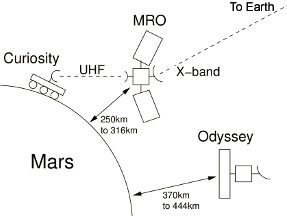 A very good description of the communications with Mars is provided by Steven Gordon (from whom the diagram on the left is shamelessly plagiarised). The transmitter power used on Mars is 5 Watts (7 dBW), so in order to cause interference from Earth, a transmitter power of around 107 dBW, or 50,000,000,000 Watts (a.k.a. 50 GigaWatts) would be required. Would it be possible to generate such a signal?
A very good description of the communications with Mars is provided by Steven Gordon (from whom the diagram on the left is shamelessly plagiarised). The transmitter power used on Mars is 5 Watts (7 dBW), so in order to cause interference from Earth, a transmitter power of around 107 dBW, or 50,000,000,000 Watts (a.k.a. 50 GigaWatts) would be required. Would it be possible to generate such a signal?Firstly, it ought to be possible to generate at least 100,000 Watts (100 kiloWatts or 50 dBW) of power at the necessary frequencies as television transmitters for the UHF band that reach this level are available. So what is then required is an antenna with a gain of 57 dB. This requires a dish with a diameter of around 150 metres. The largest dish antenna in the world is the radio telescope at Arecibo, Puerto Rico, which is 305 metres in diameter.
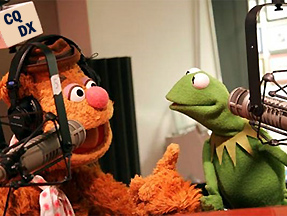 If a high powered television transmitter was therefore connected up to the Arecibo radio telescope antenna, it ought to be more than possible to jam the transmissions between the Mars rovers and the orbiting satellites during periods where the Earth and Mars were closely aligned. Of course this kind of power level is way beyond the normal licensing conditions of a typical radio amateur and the right conditions would occur roughly every 2 to 3 years when the Earth and Mars come closer together. Nonetheless, commenting on this finding, Arthur Dent of the MUPPETs jeered,
If a high powered television transmitter was therefore connected up to the Arecibo radio telescope antenna, it ought to be more than possible to jam the transmissions between the Mars rovers and the orbiting satellites during periods where the Earth and Mars were closely aligned. Of course this kind of power level is way beyond the normal licensing conditions of a typical radio amateur and the right conditions would occur roughly every 2 to 3 years when the Earth and Mars come closer together. Nonetheless, commenting on this finding, Arthur Dent of the MUPPETs jeered,Safe from interference, eh? Who looks silly now then Jeltz!
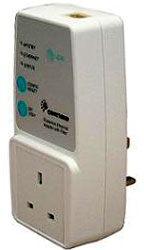 On several past occasions, dating back to 2008, Wireless Waffle has reported on how several users of the short wave spectrum including radio amateurs, broadcasters, air traffic controllers and NATO, have raised concerns about interference caused by power-line telecommunications (PLT) devices (such as the Comtrend unit pictured on the right). PLT devices allow the use of home electrical wiring to carry computer data by injecting radio signals over the wires. As electrical wiring is designed to carry signals with a frequency of 50 Hz and not 5 MHz, the injected radio signals have a tendency to leak out everywhere and cause radio interference over a wide area.
On several past occasions, dating back to 2008, Wireless Waffle has reported on how several users of the short wave spectrum including radio amateurs, broadcasters, air traffic controllers and NATO, have raised concerns about interference caused by power-line telecommunications (PLT) devices (such as the Comtrend unit pictured on the right). PLT devices allow the use of home electrical wiring to carry computer data by injecting radio signals over the wires. As electrical wiring is designed to carry signals with a frequency of 50 Hz and not 5 MHz, the injected radio signals have a tendency to leak out everywhere and cause radio interference over a wide area. Groups such as UKQRM and Ban PLT have long campaigned that PLT devices (also known as Power Line Adapters) should be taken off the market as they do not comply with the relevant emissions standards.
Over all of this period, the UK spectrum regulator Ofcom, has staunchly refused to accept that these devices contravene any regulations, though they have taken action in a number of cases where the interference they cause has exceeded even their expectations. Over the same timeframe, a number of other devices have also been found to cause high levels of radio interference, particularly cheap electrical devices, often imported on the grey market from China. These include things such as laptop power supplies, LED lighting and solar panel electrical controllers. Yet Ofcom continued to refuse to accept that anything needed doing.
It is therefore somewhat of a bolt from the blue that on January 15th, Ofcom released a consultation document, entitled 'Notice of proposals to make The Wireless Telegraphy (Control of Interference from Apparatus) Regulations 2015' in which it wishes to implement new controls over these devices by making it a criminal offence to operate them if they are causing interference to wireless telegraphy (e.g. radio services). Part of this seems to be driven by the fact that Ofcom were unable to deal with many interference complaints under existing regulations and that this could be regarded as a potential safety-of-life threat where the interference was caused to, for example, aeronautical services.
According to the consultation paper, there were 114 cases of interference reported in 2014, 'where undue interference was caused ... and capable of resolution'. Of those 114 cases, only 3 could be cured quickly using existing legislation and in the other cases it required voluntary action by the user of the equipment to bring about a solution. Under the proposed changes, all of these cases could be dealt with by law, meaning that instead of volunteering to fix the problem, users could be prosecuted if they didn't.
 The big question has to be whether such a change would make any difference. Would those selling the devices stop doing so? Presumably not, as there is no law against selling them, just using them. Would they warn buyers of the new law? Not if it damaged sales. And what will happen if Ofcom threaten prosecution to someone who believes they have been using equipment quite legally, having purchased it legitimately, and having seen the various markings on the box that said it complied with the necessary standards? Will Ofcom then look silly for allowing such devices to have been sold in the first place? Sadly, the UK legislation on such things is still somewhat muddy. It is possible to sell, for example, FM transmitters, mobile signal boosters and even GPS jammers. It is just not legal to plug them in and use them.
The big question has to be whether such a change would make any difference. Would those selling the devices stop doing so? Presumably not, as there is no law against selling them, just using them. Would they warn buyers of the new law? Not if it damaged sales. And what will happen if Ofcom threaten prosecution to someone who believes they have been using equipment quite legally, having purchased it legitimately, and having seen the various markings on the box that said it complied with the necessary standards? Will Ofcom then look silly for allowing such devices to have been sold in the first place? Sadly, the UK legislation on such things is still somewhat muddy. It is possible to sell, for example, FM transmitters, mobile signal boosters and even GPS jammers. It is just not legal to plug them in and use them.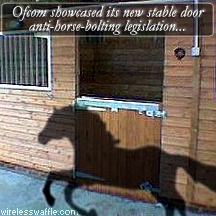 Ban PLT are recommending that as many people as possible respond to the consultation, encouraging the changes to be implemented. No doubt organisations which manufacture or sell the devices will be arguing against the changes and so it is important that those who use the radio spectrum, especially the short wave spectrum, respond to show the strength of feeling.
Ban PLT are recommending that as many people as possible respond to the consultation, encouraging the changes to be implemented. No doubt organisations which manufacture or sell the devices will be arguing against the changes and so it is important that those who use the radio spectrum, especially the short wave spectrum, respond to show the strength of feeling.There is an old saying in England, 'closing the barn door after the horse has bolted'. Effectively it means trying to solve a problem, after it has happened. The new powers proposed by Ofcom may have some effect in allowing Ofcom to convince users to turn off whichever device it is that is causing the problem, but it is by no means certain that the threat of 'turn it off or we will sue' is going to win anyone any friends, Ofcom, suppliers, BT and radio listeners alike.

